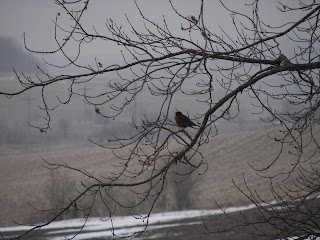Although they do migrate down from the northern reaches of Canada, they are considered year-round residents of most of the US. Typically, in the winter they are found in moist woodlands, swamps, suburbs and parks. Numbers vary greatly from winter to winter, but, you will usually see them in large winter flocks.
Their preferred diet is earthworms and insects, but, during the winter they may eat berries and apparently cracked corn. They like eating off the ground and as messy as the other cracked corn lovers are (flinging seeds in every direction), it appears they will be quite happy this winter.
Like many of our wintering birds, they nest in shrubs, trees, sheltered windowsills and eaves. They don't like the confines of bird houses. A ledge-like (or "L" shaped) shelf attached in a tree may be used - or - may not. Their nests are usually 5-15 ft. about ground.
I'd be hard-put to find anyone reading a garden article to be unfamiliar with our American Robin Turdus (meaning Thrush family) migratorius (meaning migrating). Still - there are some facts that you might find interesting:
There song is a cheerily cheer-up cheerio and their call is tut tut tut. (Who makes up this stuff?)
The female lays 3-5 blue-green eggs in a well-made cup of mud reinforced with grass and twigs and lined with softer grasses. The nest is built by the female and only used once. It is one of the earliest species to lay their eggs in the Spring. American Robins usually have two broods a season. Both the male and female protect and feed their brood.
Robins originally nested only in forests and these are much shyer than those we see in our yards. If you have cedars in your yard, chances are that's where your winter Robin is nesting. Because cedars are plentiful in this area, it's like a hotel sign saying "vacancy".
Even though we generally think of the sightings of Robins as the harbinger of spring, they may just be hiding in your trees during those cold spells and will be especially grateful if you scatter cracked corn, berries and fruit where they can see and eat. They are visual hunters.
The Robin is not considered endangered. As a result of being used for the meat, it is now protected by the Migratory Bird Act. The American Robin is a known reservoir (carrier) for West Nile virus.
Trivia
- Robin of the Batman fame, is said to have been born on the first day of Spring and his red shirt resembles the bird's red breast.
- The color "Robin's Egg Blue" was named after the color of the bird's eggs.
- In Quebec, it is thought the first person to see a Robin in the spring will have good luck.
- The song "Rockin' Robin" was made famous by Bobby Day.


No comments:
Post a Comment